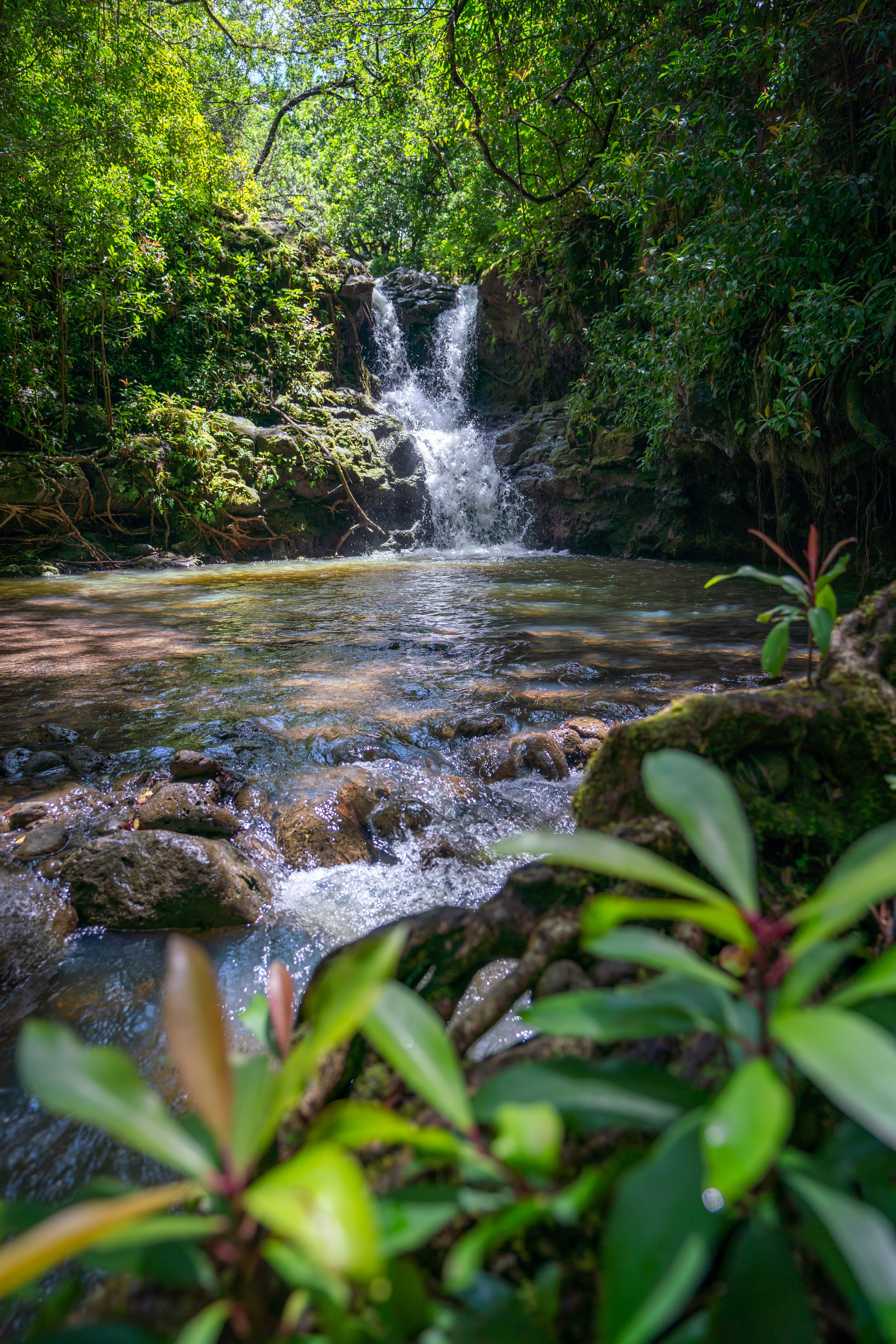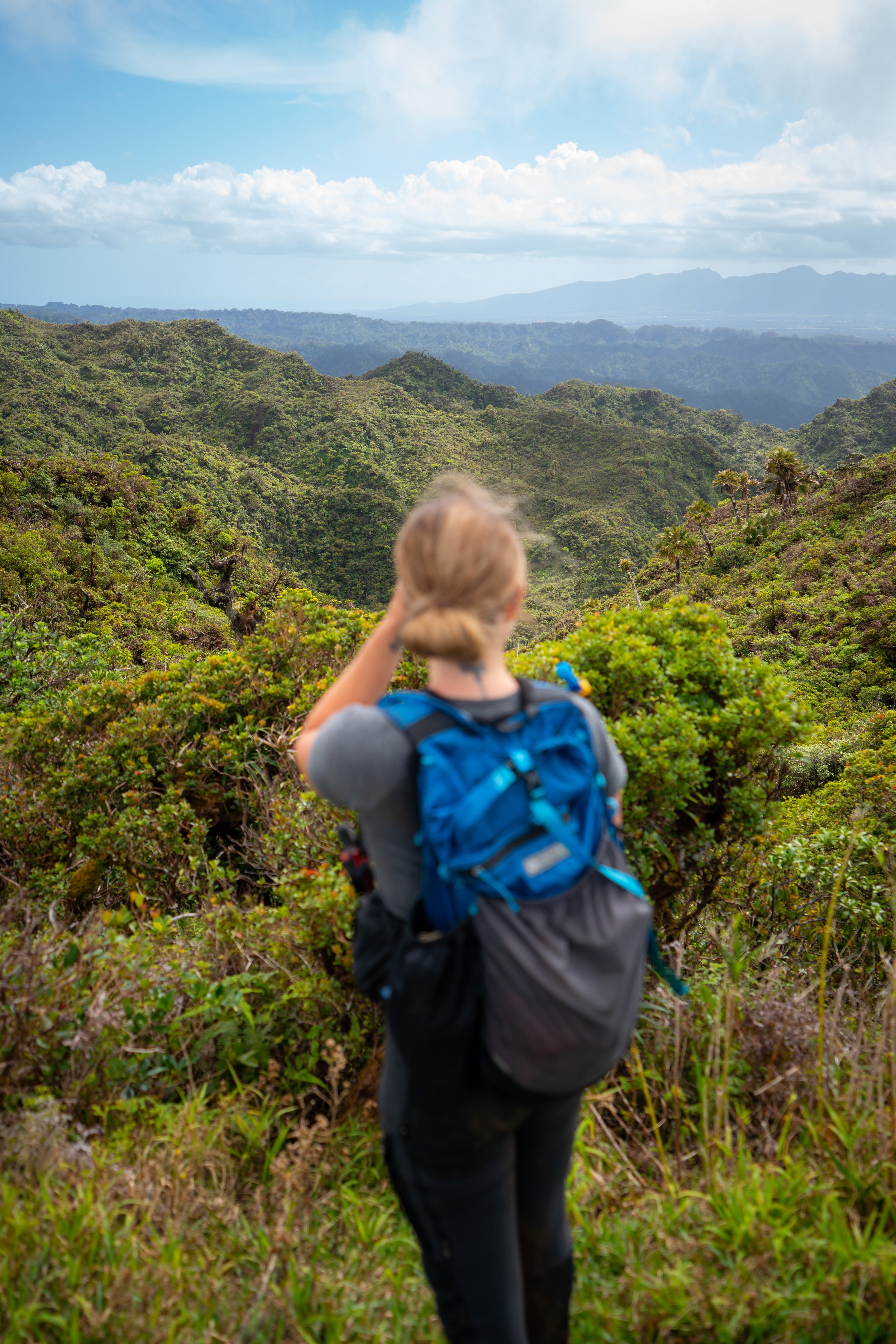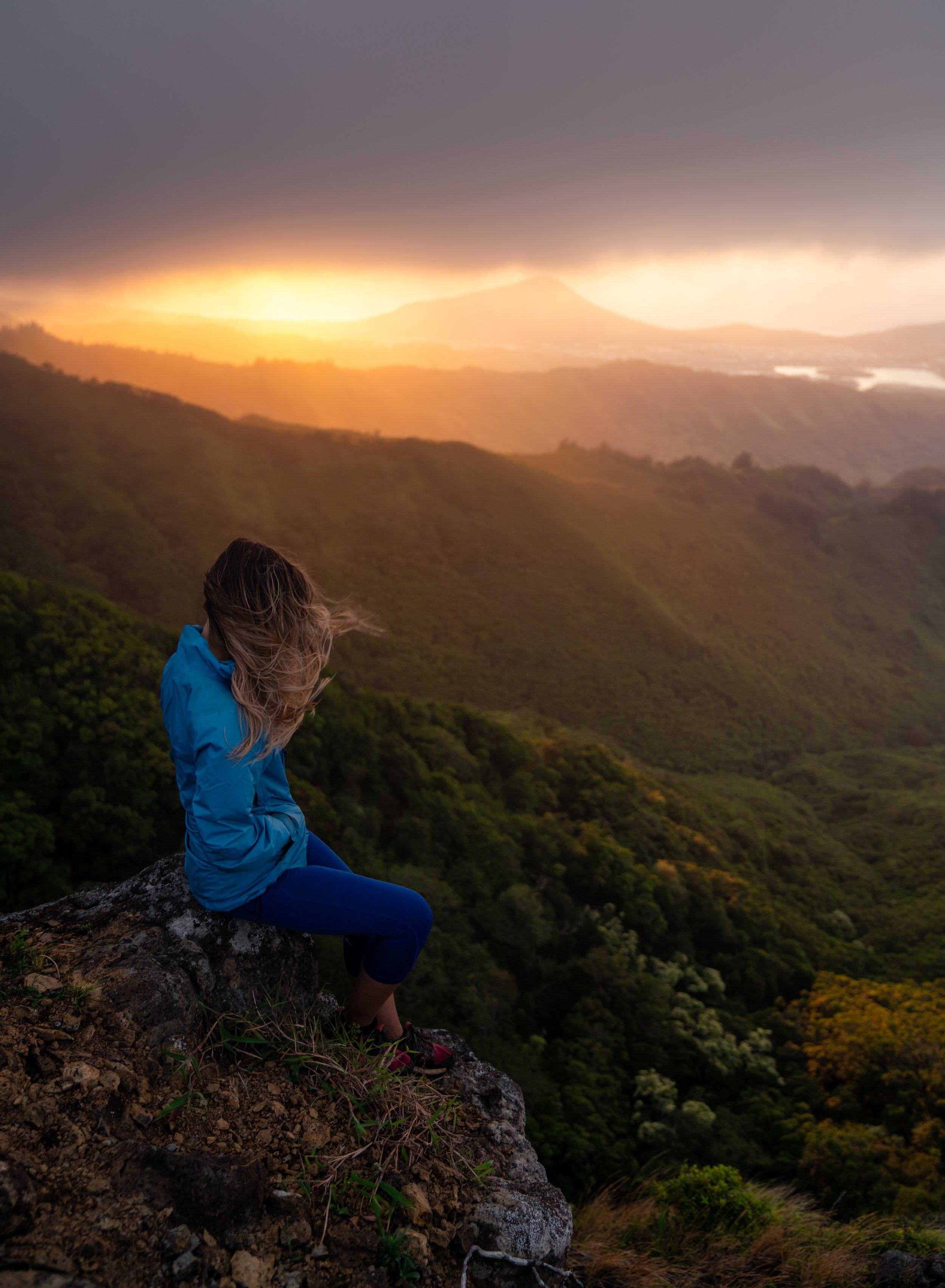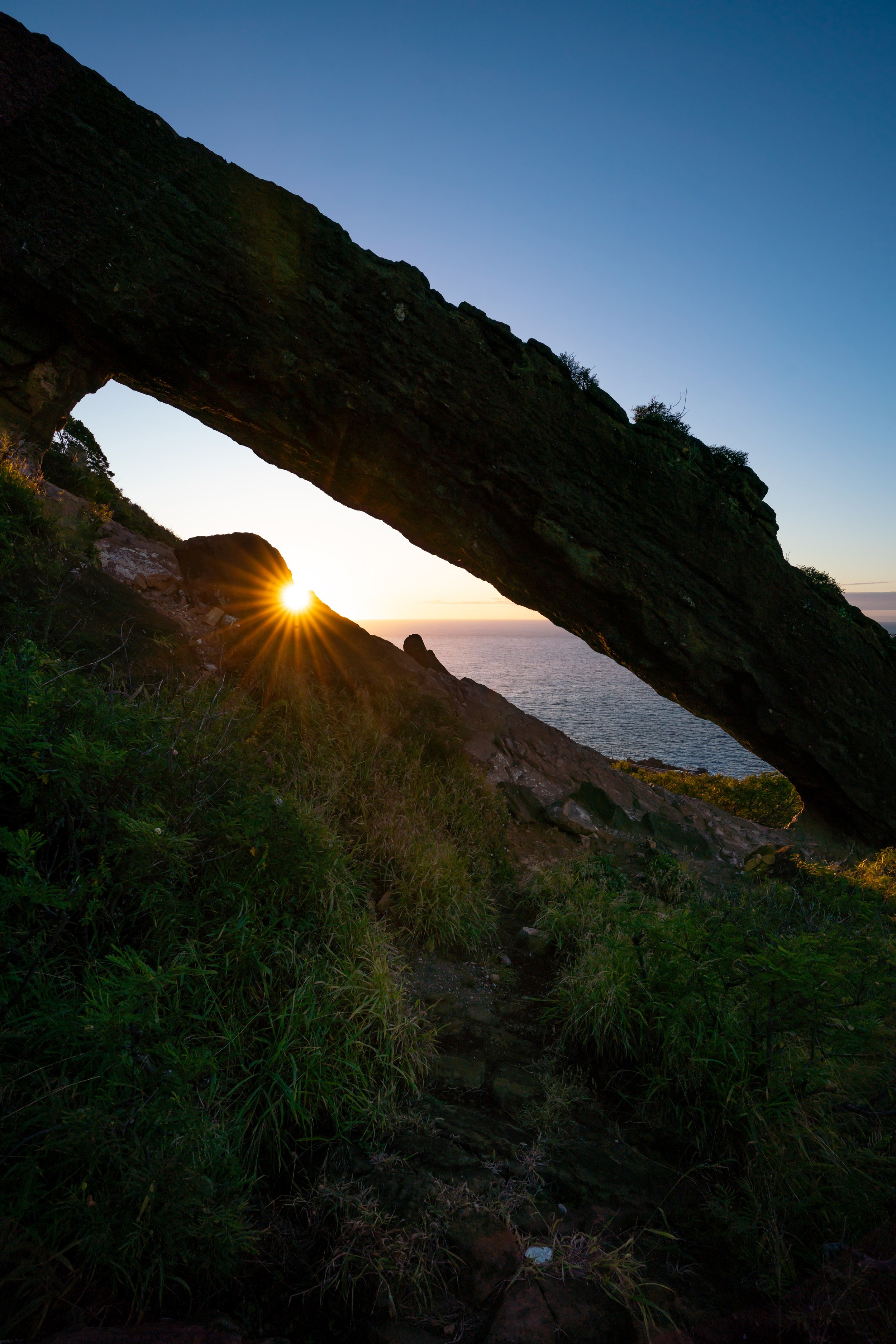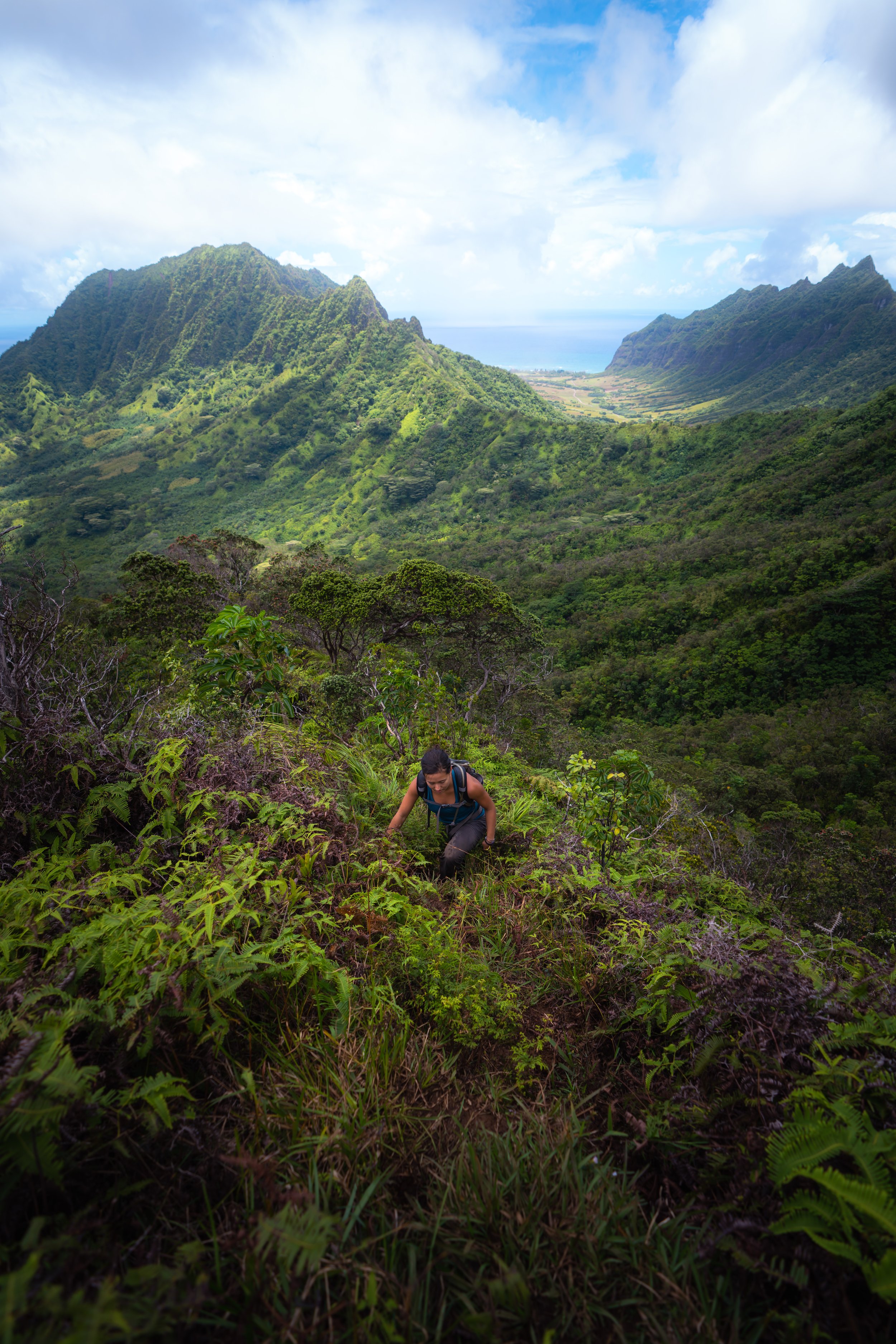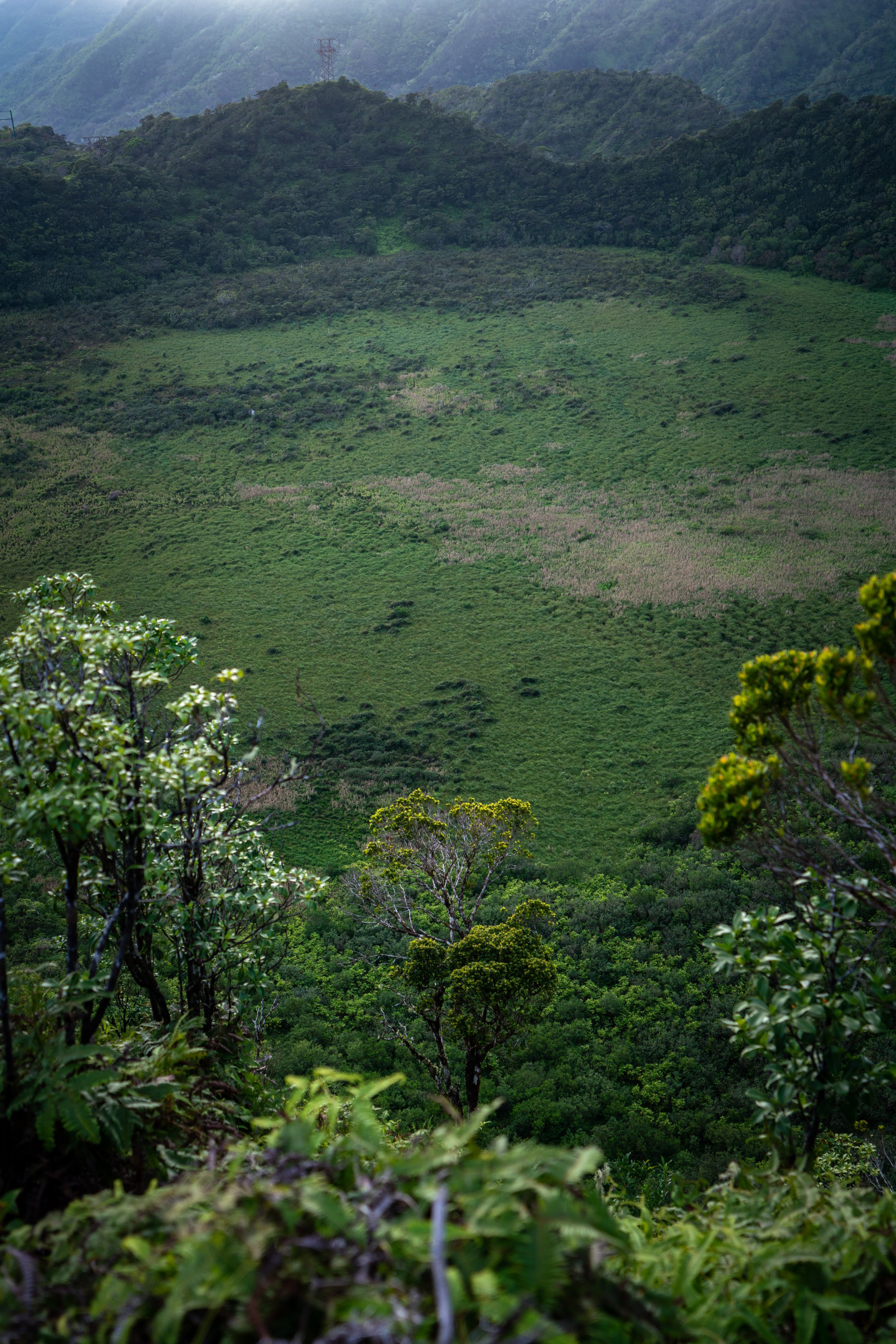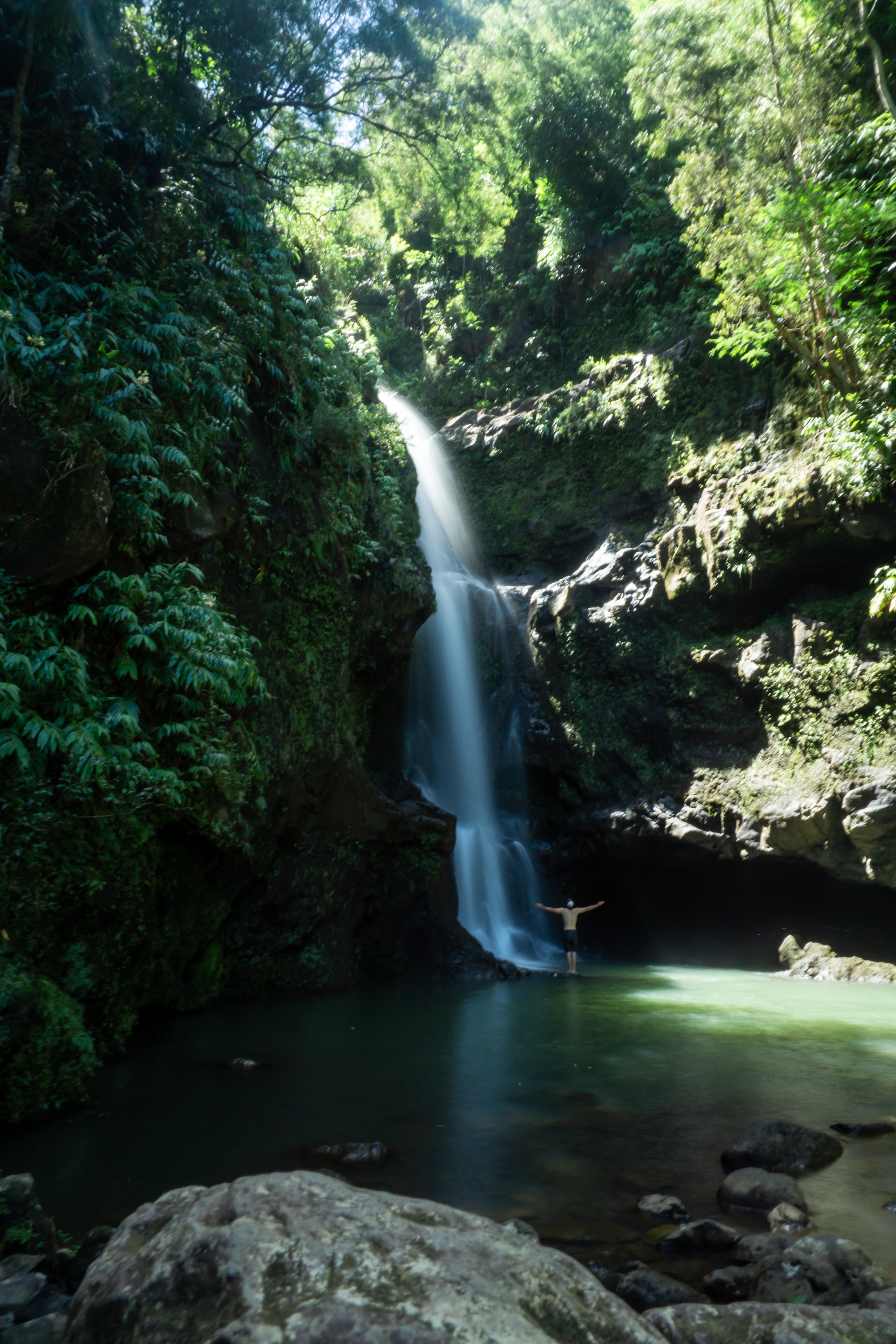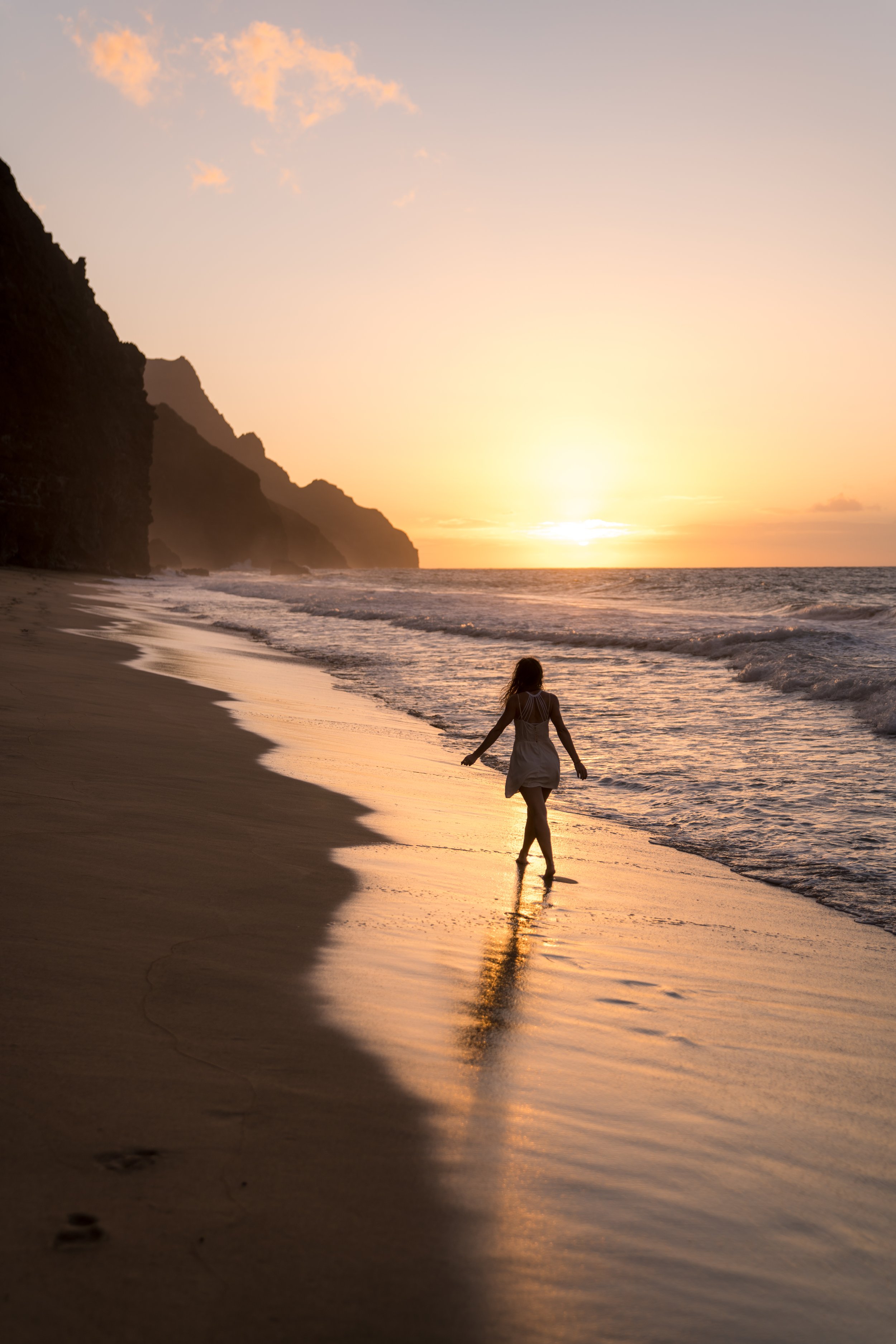Hiking the ʻĀhuimanu Falls Trail on Oʻahu, Hawaiʻi
Distance: 1.4 miles / 2.3 km
The ʻĀhuimanu Falls Trail on the windward side of Oʻahu is one of many waterfall chutes along the dramatic Koʻolau Range, similar to Temple Falls and Kahaluʻu Falls nearby, or the V Falls Trail further to the south.
However, of these examples, ʻĀhuimanu Falls is one of the easier waterfalls to hike to, as the entirety of the trail follows a path rather than a stream bed. I mention this because following a stream bed is common when it comes to Hawaiʻi gulch hikes—especially longer adventures like the Kōloa Gulch Trail on the North Shore of Oʻahu—but ʻĀhuimanu Falls is different in that the only time hikers are required to get in the stream is at the very end, just before the waterfall.
This is all goes without saying that, regardless of the trail, windward Koʻolau Oʻahu waterfalls are undoubtedly more difficult and more dangerous to hike than more maintained trails, like the Lulumahu Falls Trail. I say this to hopefully provide realistic expectations, as these trails do not see regular hiking traffic or upkeep—meaning they are inevitably more challenging to reach than other notable waterfalls.
ʻĀhuimanu Falls Trailhead Parking
Parking for the ʻĀhuimanu Falls Trail is located adjacent to the trailhead on Hui Kēlū Street or Lile Place in the back of ʻĀhuimanu Valley.
That said, please be quiet and respectful in this local residential neighborhood, as too many trails in Hawaiʻi draw too much negative attention because people just don’t understand this.
Google Maps Directions: ʻĀhuimanu Falls Trailhead
My Hawaiʻi Hiking Checklist
Osprey 3L Water Bladder - The Osprey 3L water bladder is the most universal hiking and backpacking water bladder on the market, and it’s my go-to because of the slide-off seal that allows it to be quickly filled from the top. Additionally, individual parts are easily replaceable, such as the bite valve.
Blister / Heel Protectors - I swear by these cheap, amazing heel protectors to prevent blisters for nearly every kind of hiking and backpacking that I do!
Black Diamond Headlamp - Personally, I recommend the Black Diamond Storm because it is one of the brightest, lightest, and longest-lasting headlamps on the market—and trust me, the weight-to-battery-life ratio really does matter!
Hiking / Trail Running Shoes - Depending on the type of trail, I prefer to use either the Keen Targhee for longer, more rugged hiking or the HOKA Zinal Trail-Running Shoe for lighter, less intense trails. In either case, both have been amazing to me for many years across countless environments, and both can be found in men’s and women’s sizes. - (Men’s Keen / Women’s Keen) (Men’s HOKA / Women’s HOKA)
Waterproof Rain Shell - You never know when it may rain, and I’ve learned over the years that a rain shell is far better than a rain jacket. By this, I mean that it’s best to have something that the water will roll right off of, which is why I recommend the Patagonia Torrentshell 3L available in both men’s and women’s sizes.
High SPF Sunscreen - Packing high-SPF sunscreen is a must for long days outside!
Hiking the ʻĀhuimanu Falls Trail
ʻĀhuimanu Restoration Area
This area along the ʻĀhuimanu Stream is known locally as the ʻĀhuimanu Restoration Area, as both community volunteers and the local elementary school work to restore this small community space.
It is here, at the back of the Restoration Area, that the ʻĀhuimanu Falls Trailhead can be found.
ʻĀhuimanu Falls Trailhead (ʻĀhuimanu Terrace Complex)
These signs refer to the ʻĀhuimanu Terrace Complex, which extends from this trailhead off Hui Kēlū Place to the uppermost portions of ʻĀhuimanu Valley.
With that in mind, please do everything you can to avoid touching, standing on, or disturbing the terrace walls, as they represent the largest intact wetland Taro system across all of Oʻahu—not to mention, the complex is recognized in the National Register of Historic Places.
Following the trailhead, the ʻĀhuimanu Falls Trail will turn away from the ʻĀhuimanu Stream until it reaches the first of three stream crossings, about 0.4 mile (0.6 km) into the hike.
These short iron-rung ladders are in place to protect the historic dry-stacked terrace walls.
At this second sign about the ʻĀhuimanu Taro Complex, the trail makes a hard left-hand turn to continue up the valley.
Climbing over fallen trees is certainly not uncommon on the ʻĀhuimanu Falls Trail, as the hike is typically only maintained by community volunteers.
An entanglement of Hau trees, such as this, is seemingly a familiar experience on Hawaiʻi trails, as countless day hikes across the islands—like the Kulanaʻahane Trail in Moanalua Valley or the Waimano Ridge Trail—navigate through very similar sections.
Hawaiʻi’s indigenous ʻĒkaha fern is one of the more common native plants on the ʻĀhuimanu Falls Trail.
While ʻŌhiʻa ʻAi, or Mountain Apple, is not a native Hawaiian species, it is a canoe plant—meaning it was brought to Hawaiʻi by the first Polynesians.
However, it’s always better to find larger Mountain Apple trees that actually have fruit, but keep an eye out, as they grow across most areas of the trail.
These are more of the dry-stacked walls in the complex that extend all the way to the back of ʻĀhuimanu Valley — the wall just before the third and final stream crossing.
ʻĀhuimanu Stream
When the ʻĀhuimanu Falls Trail comes to this split, go right to cross the stream.
While it may seem as if there’s a trail heading up the valley without crossing the stream, do not follow it. This alternative route is largely created by hikers going a short distance up, then turning back to this crossing, because the trail going straight is unnecessarily more difficult in comparison.
Warning
If this first stream crossing is borderline or too difficult to cross, don’t attempt to continue up to ʻĀhuimanu Falls.
I say this because the final section of the trail navigates up a narrow gulch, where a flash flood can have the greatest consequences—meaning, if it’s too difficult to cross here, the final section of the trail will certainly be more challenging and unnecessarily risky in comparison.
After the first stream crossing, the ʻĀhuimanu Falls Trail will 'seemingly' climb high and away from the stream, but in fact, these uppermost portions of the valley are where the stream descends most rapidly.
This is why sticking to the true trail, shown here, is always easier than trying to follow the stream at the split shown above.
ʻĀhuimanu Falls-Heno Junction
This junction is one of only two times that the ʻĀhuimanu Falls Trail splits, with the trail to the right leading to two alternative trailheads at the back of ʻĀhuimanu Valley.
That said, go left to continue on the ʻĀhuimanu Falls Trail up the valley, as both trails that diverge to the right end on private property. This is why the trailhead shown at the beginning—the ʻĀhuimanu Terrace Complex Trailhead—is the only one I recommend.
On a different note, if you return to the final stream crossing and it appears to be too dangerous to cross on a rainy day, follow this trail down to one of the two alternative trailheads on Heno or Hui Kēlū Place. Both of these options are certainly a better alternative than taking an unnecessary risk.
This is the invasive Kahili Ginger, and it’s known for being one of Hawaiʻi’s most noxious weeds—especially in more pristine environments, like Puʻu Kōnāhuanui (K1) and Hawaiʻi Volcanoes National Park.
But here, I can say that ʻĀhuimanu Valley did not look like this a number of years ago, and it’s truly unfortunate how many areas across the islands it has spread.
This is the second of three times the ʻĀhuimanu Falls Trail crosses the ʻĀhuimanu Stream, with the final crossing just a short distance ahead.
Shortly after the second crossing, the ʻĀhuimanu Falls Trail comes to this headwall at the base of the Koʻolau Range, as well as the alternative—and honestly unnecessary—route that split at the first stream crossing.
That said, go right to follow this wall to reach the third stream crossing a short distance ahead.
This is the third and final ʻĀhuimanu Stream crossing.
Following the final stream crossing, the ʻĀhuimanu Falls Trail begins a short but steep climb along the banks of the upper gulch.
However, this quickly levels out, as the waterfall is only 0.1 miles (0.2 km) from the third crossing.
It’s always great to find Māmaki on Hawaiʻi trails, but if you’re curious to try Māmaki tea, I ask that you please don’t harvest from Hawaiʻi’s native landscapes.
Instead, Māmaki can be purchased, as it is grown commonly for commercial purposes.
This is where the trail ends, and the final part of the hike follows the stream up to ʻĀhuimanu Falls just ahead.
ʻĀhuimanu Falls
ʻĀhuimanu Falls is a multi-tiered waterfall that descends more than 1,000 ft. (305 m) from a small drainage below the Koʻolau Summit, with the final two drops making up the portion of the waterfall that is visible from the hike.
That said, the full extent of ʻĀhuimanu Falls can actually be appreciated better from the neighborhood in ʻĀhuimanu Valley or with a drone from above, as there are additional drops that can’t be seen from the end of the trail.
All this to say, ʻĀhuimanu Falls—like many other Koʻolau waterfalls—are rainy-day adventures, meaning they don’t flow unless enough rain falls in a short period of time.
However, hiking on a rainy day in Hawaiʻi comes with its own inherent risks, as flash floods can be a scary—and even deadly—reality across the islands. Therefore, my best advice is to try hiking the trail just after the rain has cleared.
Also, understand that returning down the same ʻĀhuimanu Falls Trail isn’t a good idea if the stream suddenly swells before you have the opportunity to cross. I can speak from experience that bushwhacking to avoid crossing a stream is, by far, a better alternative than returning on the ʻĀhuimanu Falls Trail just to finish at the Taro Complex Trailhead.
Native Plants on the ʻĀhuimanu Falls Trail
ʻĀhuimanu Valley is relatively low in elevation in terms of Hawaiʻi’s forests, meaning the vast majority of the trail is dominated by non-native, invasive species.
However, there are sporadic native plants to look out for, including in the ʻĀhuimanu Restoration Area at the trailhead.
As for the hike, some native Hawaiian plants that can be seen on the ʻĀhuimanu Falls Trail include Māmaki, ʻĒkaha, Pāpala Kēpau, Hala, and Hau, among a number of canoe plants like Kukui, ʻAwapuhi, and ʻŌhiʻa ʻAi.
If you are curious about trying the native Hawaiian Māmaki tea, I kindly ask that you don’t harvest Māmaki from our native forests but, instead, buy from one of the local reputable vendors, such as those listed below.
If you would like to learn more about these and many other native Hawaiian plants from across the islands, I encourage you to check out my separate post linked below.
Read My Separate Post: Native Hawaiian Plant Guide
More Oʻahu Adventures
If you’re interested in reading about some more amazing Oʻahu adventures, check out my separate posts below!
Best Hotels & Restaurants in Waikīkī
If you’re trying to decided where to stay on Oʻahu, check out my top 10 list for the best resorts and restaurants in Waikīkī.
I break down what makes one hotel a better choice over another, so that you can find the best fit for your stay on the island.
Read My Separate Post: Best Waikīkī Hotels & Restaurants
HNL Airport-Hotel Shuttle
Prices on ride-share apps like Uber/ Lyft cannot beat the price of booking your hotel shuttle prior to arrival. I say this because there are additional fees for ride-share airport pick-ups at Honolulu Airport (HNL), which is why I recommend booking your transportation in advance using the options below.
Additionally, the last option below will go as far as the Ko ʻOlina Resorts on the West Side and Turtle Bay on Oʻahu’s North Shore!
Best Way to Book Rental Cars!
I travel quite a bit, and I know firsthand that finding a good rental car deal can be a challenge, but that’s why I recommend comparing all of your options with Discover Cars.
In short, Discover Cars is a well-known, reputable business that allows you to search for the best deal across companies, and they have the best full-refund cancellation policy I’ve ever seen, valid up to 72, or sometimes even 48, hours prior to your reservation!
Book Here: Discover Cars
Visiting Other Islands
If you are visiting Oʻahu or heading to another island, check out some of my personal recommendations for Oʻahu, Maui, Kauaʻi, Molokai, Lānaʻi, and Hawaiʻi Island (Big Island) in these separate posts.
If you’re trying to decide which island is right for your visit, check out my overview about each island in the post below.
Read My Separate Post: What is the Best Hawaiian Island to Visit?
What is the Best Time of Year to Visit Hawaiʻi?
The weather in Hawaiʻi can often appear to be warm and beautiful throughout the year, but in my experience, there is a lot more to consider when planning what time of year to visit the islands, such as what island you are considering, what sides of each island do you plan to stay, what activities are you most interested in, the wildlife, and countless other nuanced variables that can all impact the type of trip you can expect to have.
For these reasons, I highly recommend reading through my separate article to not only understand my thoughts regarding the best time of year to come to Hawaiʻi but also what you need to consider based on the time of year that you plan to visit.
Read My Separate Post: What is the Best Time of Year to Visit Hawaiʻi?
10 Best Tours & Excursions on Oʻahu
There are a lot of different tour options to choose from on Oʻahu, but to make it easier to decide, I made a list of my favorite tours because some things simply are better with a local guide!
Read My Separate Post: Best Tours on Oʻahu
Safety
All hikes in Hawaiʻi should not be compared to trails outside of the islands, and hikers should exercise due caution on every adventure, given that many are extremely dangerous.
By this, I mean that Hawaiʻi is known for hot, humid weather, steep, dramatic, and unstable cliffs, and flash floods, which can occur without warning. Therefore, it is important that you check the local forecast, understand the physical condition of your entire group, and pack sufficient food and water before attempting any adventure.
Disclaimer
All information provided on this blog is for informational purposes only and is not intended to be a substitute for information or advice from qualified professionals or managing agencies.
Noah Lang Photography LLC makes no representations or warranties regarding the accuracy or completeness of the information provided here, and readers should use their own discretion, judgement, and seek professional advice where it is appropriate.
Furthermore, Noah Lang Photography LLC shall not be held responsible for any injuries, lost individuals, or legal issues arising from the use of information provided on this website, and if applicable, the above safety disclaimer should be referenced to provide a generic overview of the risks involved.
All said, the content on this blog is for the sole use of Noah Lang Photography LLC, and unauthorized use or reproduction of this content is strictly prohibited.
Disclosure
This post is not sponsored.
However, some of the links in this post are affiliate links, which means that I may earn a small commission if a purchase is made through one of those links. This commission comes at no additional cost to you, and I only recommend products that I personally use and believe will add value to my readers. Thank you for your support, which enables me to continue creating more!
To read the full privacy policy, click here.

About This Blog
Noah Lang Photography, also known as @noahawaii, is 100% reader-supported!
I do not accept guest articles or sponsored content of any kind on my blog, which is why, if you enjoy the outdoor and travel content I create, please consider buying me a coffee!
I appreciate your support, which helps me continue to keep this blog alive!












